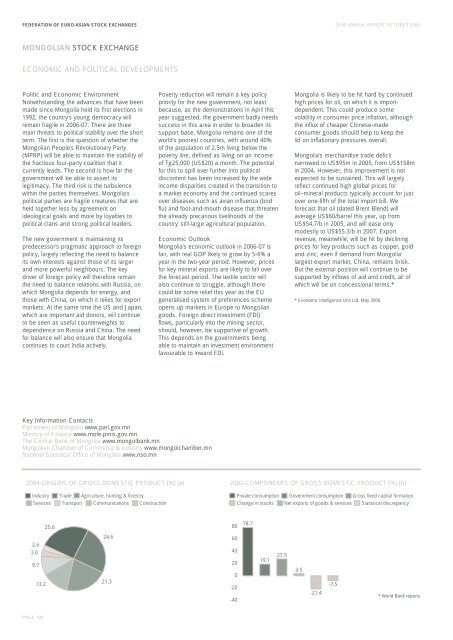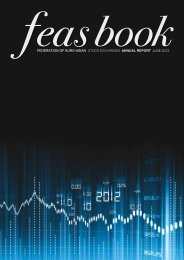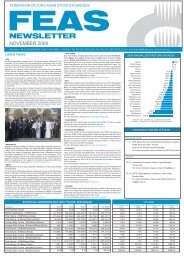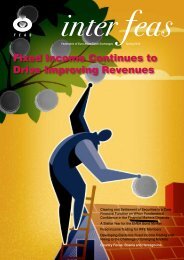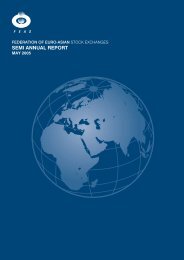Download - FEAS
Download - FEAS
Download - FEAS
Create successful ePaper yourself
Turn your PDF publications into a flip-book with our unique Google optimized e-Paper software.
FEDERATION OF EURO-ASIAN STOCK EXCHANGES SEMI ANNUAL REPORT OCTOBER 2006<br />
MONGOLIAN STOCK EXCHANGE<br />
ECONOMIC AND POLITICAL DEVELOPMENTS<br />
Politic and Economic Environment<br />
Notwithstanding the advances that have been<br />
made since Mongolia held its first elections in<br />
1992, the country's young democracy will<br />
remain fragile in 2006-07. There are three<br />
main threats to political stability over the short<br />
term. The first is the question of whether the<br />
Mongolian People's Revolutionary Party<br />
(MPRP) will be able to maintain the stability of<br />
the fractious four-party coalition that it<br />
currently leads. The second is how far the<br />
government will be able to assert its<br />
legitimacy. The third risk is the turbulence<br />
within the parties themselves. Mongolia's<br />
political parties are fragile creatures that are<br />
held together less by agreement on<br />
ideological goals and more by loyalties to<br />
political clans and strong political leaders.<br />
The new government is maintaining its<br />
predecessor's pragmatic approach to foreign<br />
policy, largely reflecting the need to balance<br />
its own interests against those of its larger<br />
and more powerful neighbours. The key<br />
driver of foreign policy will therefore remain<br />
the need to balance relations with Russia, on<br />
which Mongolia depends for energy, and<br />
those with China, on which it relies for export<br />
markets. At the same time the US and Japan,<br />
which are important aid donors, will continue<br />
to be seen as useful counterweights to<br />
dependence on Russia and China. The need<br />
for balance will also ensure that Mongolia<br />
continues to court India actively.<br />
Poverty reduction will remain a key policy<br />
priority for the new government, not least<br />
because, as the demonstrations in April this<br />
year suggested, the government badly needs<br />
success in this area in order to broaden its<br />
support base. Mongolia remains one of the<br />
world's poorest countries, with around 40%<br />
of the population of 2.5m living below the<br />
poverty line, defined as living on an income<br />
of Tg25,000 (US$20) a month. The potential<br />
for this to spill over further into political<br />
discontent has been increased by the wide<br />
income disparities created in the transition to<br />
a market economy and the continued scares<br />
over diseases such as avian influenza (bird<br />
flu) and foot-and-mouth disease that threaten<br />
the already precarious livelihoods of the<br />
country' still-large agricultural population.<br />
Economic Outlook<br />
Mongolia's economic outlook in 2006-07 is<br />
fair, with real GDP likely to grow by 5-6% a<br />
year in the two-year period. However, prices<br />
for key mineral exports are likely to fall over<br />
the forecast period. The textile sector will<br />
also continue to struggle, although there<br />
could be some relief this year as the EU<br />
generalised system of preferences scheme<br />
opens up markets in Europe to Mongolian<br />
goods. Foreign direct investment (FDI)<br />
flows, particularly into the mining sector,<br />
should, however, be supportive of growth.<br />
This depends on the government's being<br />
able to maintain an investment environment<br />
favourable to inward FDI.<br />
Mongolia is likely to be hit hard by continued<br />
high prices for oil, on which it is importdependent.<br />
This could produce some<br />
volatility in consumer price inflation, although<br />
the influx of cheaper Chinese-made<br />
consumer goods should help to keep the<br />
lid on inflationary pressures overall.<br />
Mongolia's merchandise trade deficit<br />
narrowed to US$95m in 2005, from US$158m<br />
in 2004. However, this improvement is not<br />
expected to be sustained. This will largely<br />
reflect continued high global prices for<br />
oil–mineral products typically account for just<br />
over one-fifth of the total import bill. We<br />
forecast that oil (dated Brent Blend) will<br />
average US$60/barrel this year, up from<br />
US$54.7/b in 2005, and will ease only<br />
modestly to US$55.3/b in 2007. Export<br />
revenue, meanwhile, will be hit by declining<br />
prices for key products such as copper, gold<br />
and zinc, even if demand from Mongolia'<br />
largest export market, China, remains brisk.<br />
But the external position will continue to be<br />
supported by inflows of aid and credit, all of<br />
which will be on concessional terms.*<br />
* Economic Intelligence Unit Ltd, May 2006<br />
Key Information Contacts<br />
Parliament of Mongolia www.parl.gov.mn<br />
Ministry of Finance www.mofe.pmis.gov.mn<br />
The Central Bank of Mongolia www.mongolbank.mn<br />
Mongolian Chamber of Commerce & Industry www.mongolchamber.mn<br />
National Statistical Office of Mongolia www.nso.mn<br />
2004-ORIGINS OF GROSS DOMESTIC PRODUCT (%) (a)<br />
2003-COMPONENTS OF GROSS DOMESTIC PRODUCT (%) (b)<br />
Industry<br />
Services<br />
Trade Agriculture, hunting & forestry<br />
Transport Communications Construction<br />
Private consumption Government consumption Gross fixed capital formation<br />
Change in stocks Net exports of goods & services Statistical discrepancy<br />
25.6<br />
80<br />
78.7<br />
2.6<br />
3.0<br />
9.7<br />
13.2<br />
24.6<br />
21.3<br />
60<br />
40<br />
20<br />
0<br />
-20<br />
-40<br />
19.1<br />
27.5<br />
3.5<br />
-21.4<br />
-7.5<br />
* World Bank reports<br />
PAGE 108


